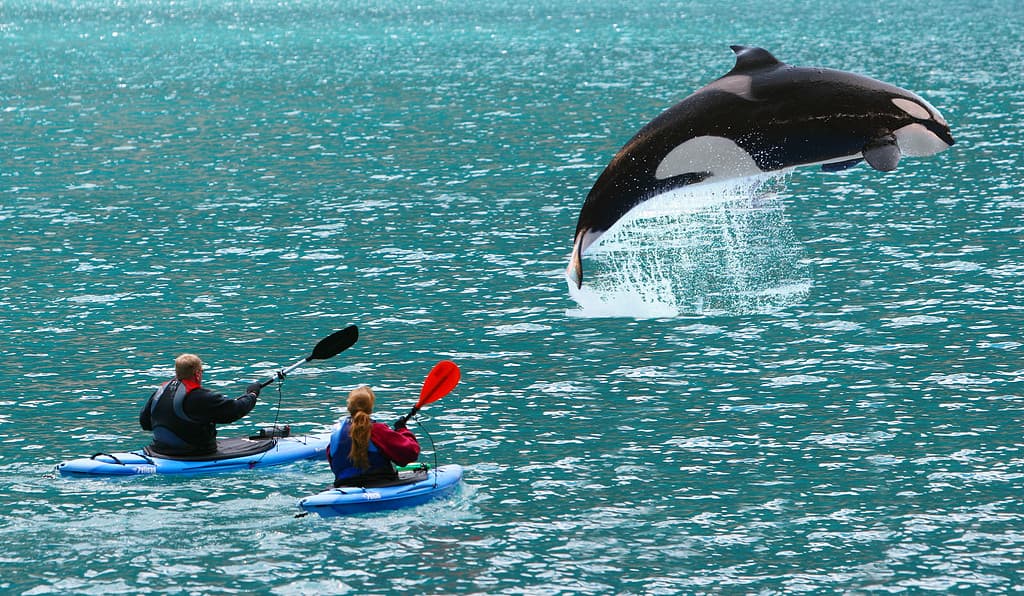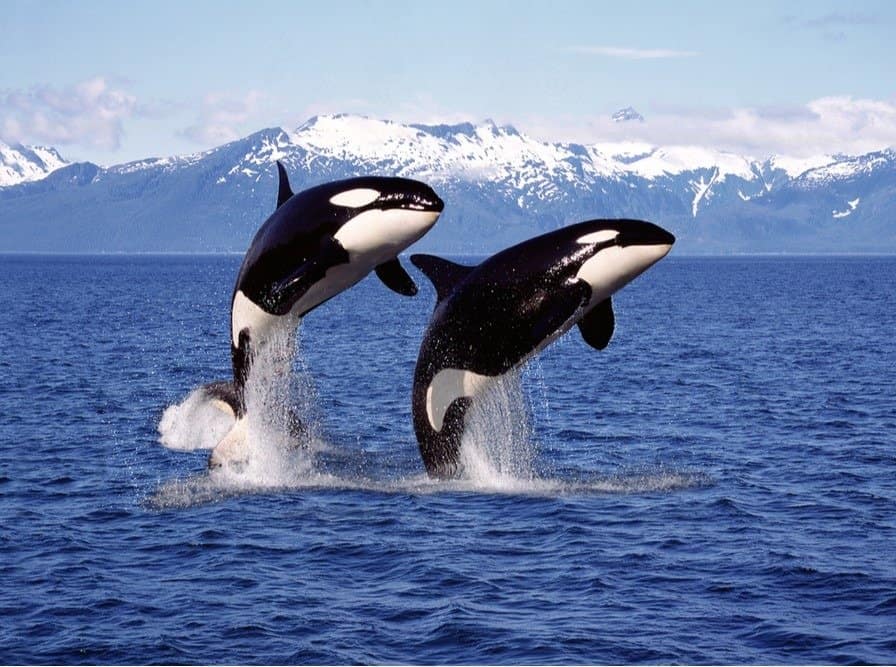Despite their name, killer whales do not pose a threat to human life. Humans, on the other hand, are extremely dangerous to certain killer whale populations through various means. Boat encounters, entanglement in fishing nets, and captivity all threaten killer whales. Though orcas have never proven a problem for people, these marine animals have attacked boats with humans onboard in recent years. The Iberian Peninsula is the site of these attacks, and researchers and conservationists remain unsure of the motives behind such offenses. Discover theories behind recent boat attacks and find out what threatens these beautiful whales.

Killer whales and humans often get along nicely, and attacks on humans do not occur in the wild.
©Mayskyphoto/Shutterstock.com
Background on Killer Whales
Killer whales, also referred to as orcas, belong to the dolphin family and swim all over the world. These black and white whales are easy to recognize. The killer whale’s back, including its dorsal fin, is black, and its underbelly is white.
Males may exceed 32.8 feet in length. They also weigh around 11 tons, which translates to 22,000 pounds! On the other hand, females are much smaller than their male counterparts, measuring a maximum of 27.8 feet long. Females also weigh less than males, between 8,000 and 16,000 pounds. One interesting fact about killer whales is they have the largest brain of all dolphin species, averaging a weight of 12.3 pounds.
Their diet includes seals, squid, penguins, various types of fish, and other whales. When feeding and communicating, killer whales often use echolocation to detect prey and other members of their groups. In addition, these marine animals typically travel in groups called pods, which include no more than 40 individuals. Different types of pods exist, too, and they all exhibit behaviors unique to their groups. Some behaviors that differ between pod types include diet and the sounds they make.
Dangers of Killer Whales
Killer whales do not have natural predators, making them apex predators and extremely dangerous to prey. When hunting, killer whales use echolocation to detect prey. Once the prey has been discovered, the pod often strikes the unsuspecting animals with their tails. Due to their high intelligence, killer whales can work together to create attack strategies that leave prey completely defenseless. However, while killer whales pose extreme danger to many marine animals, they do not pose threats to humans in the wild.

Killer whales are one of the only marine animals big enough to conquer the largest seal species.
©vladsilver/Shutterstock.com
Killer Whale Attacks on Boats
Over the last three years, killer whales off the coast of the Iberian Peninsula, which consists of countries like Portugal and Spain, sunk three boats. Interestingly, these attacks have not been reported anywhere else in the world. Thankfully, all humans onboard were rescued in all three attacks. The most recent attack occurred in early May of 2023. Since 2020, groups of killer whales have consistently attacked boats, often biting the rudder. When killer whales go after the boat’s rudder, the boat can no longer navigate the ocean.
While only three boats met their fate due to killer whale attacks, the marine animals have attacked far more vessels. However, of the 505 instances since 2020 in which killer whales encountered boats, very few encounters led to attacks. But with instances of killer whale attacks happening more and more frequently, sailors and scientists are left puzzled.
Why are Killer Whales Purposefully Attacking Boats?
Ultimately, researchers propose two main reasons behind the killer whales’ desire to sink ships. First, a pod of killer whales could have started a trend of attacking boats. Dolphins and whales are prone to creating trends amongst their species. In this case, it’s possible that some young killer whales decided that it would be fun to sink boats off the Iberian Peninsula. As other pod members noticed these trendsetters, they may have decided to follow along.
Perhaps another reason behind the continuous attacks is that these killer whales experienced a prior negative encounter with a boat. To protect themselves from future bad boat encounters, the killer whales may have determined that sinking boats altogether was the best course of action. The true explanation might consist of a combination of both of these reasons.
Scientists identified two groups of killer whales as the culprits of these attacks. The first group is comprised of juveniles, who, perhaps, are the trendsetters that scientists are looking for. On the other hand, the second group consists of killer whales of multiple ages with only one adult.
In the second group, a killer whale called White Gladis remains the only adult alongside her children and sisters. Being the only adult in group two, scientists believe that White Gladis may have become entangled in a fishing net or had a negative encounter with a boat in the past. Therefore, White Gladis and her family members could be attacking boats in this region to protect themselves and ward off dangers from humans.

Researchers aren’t positive about the motives behind killer whale attacks on boats.
©slowmotiongli/Shutterstock.com
Are Killer Whales Violent Toward Humans?
One issue with the White Gladis theory is that it does not align with killer whale behavior. Vengeful killer whale attacks resulting from negative experiences with boats have not been recorded anywhere else on Earth. Even when killer whales were captured and taken away from their homes during the 1960s and 70s, they did not retaliate against humans. In addition, no killer whales during this period attacked boats after watching members of their pods being captured. Finally, killer whales have never killed humans in the wild, though a few human fatalities have resulted from killer whale attacks in captivity.
Thus, while it’s certainly possible that White Gladis and her family harbor negative emotions toward boats, the reasoning behind these attacks might certainly derive from trend-setting juveniles. As humans, it’s impossible to know for sure the intentions of killer whales and the nuances of their psychology and emotions. One thing we can learn, though, is that killer whales do not respond well following negative boat experiences. Therefore, sailors, marine wildlife managers, and fishermen should be careful to respect their homes and leave their populations unbothered.
Threats to Killer Whales
While killer whales have no natural predators, threats posed to them often derive from human interference. For one, killer whales have been held in captivity to perform shows like those popularized by SeaWorld. However, after conservationists brought concerns about killer whale captivity to the public, many people realized how captivity can harm them. In fact, many killer whales have died in captivity and recorded shorter lifespans in these locations than in the wild. Therefore, many people debate the use of killer whales in shows, and several organizations holding killer whales in captivity have discontinued killer whale performances.
In addition, other threats to killer whales exist in their natural habitats, outside of captivity. These threats leave specific killer whale populations across the globe threatened or endangered. For example, these whales may become entangled in fishing nets, which can seriously injure them and even result in death.
Another threat to killer whales is contaminants. Pollution in the form of pesticides and sewage may enter the ocean. Seals often consume this pollution. Thus, when killer whales eat seals, they are at risk of becoming contaminated by pollutants themselves. Some outcomes of ocean contamination in killer whales include damage to the species’ reproductive systems and decreased immunity to disease.

This aerial view of SeaWorld shows where killer whales have been held in captivity.
©iStock.com/f8grapher
The photo featured at the top of this post is © slowmotiongli/Shutterstock.com
Thank you for reading! Have some feedback for us? Contact the AZ Animals editorial team.






